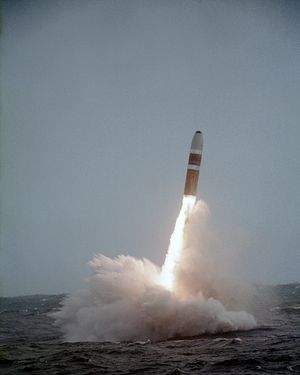According to a new report from 38 North, the blog of the U.S.-Korea Institute at the Johns Hopkins School of Advanced International Studies (SAIS), North Korea could be developing a sea-based or submarine-launched ballistic missile (SLBM) capability. 38 North bases its claims, as usual, on commercial satellite imagery analysis, which identifies a “new test stand at the North’s Sinpo South Shipyard, probably intended to explore the possibility of launching ballistic missiles from submarines or of a shipboard vertical launch ballistic missile capability.” Nothing in the report or information available on North Korea’s weapons development programs suggests that the country is anywhere close to fielding this capability in the near-term, but it nonetheless will add to South Korean and U.S. concerns about North Korea’s future plans.
Based on satellite imagery, the author of the 38 North report, Joseph S. Bermudez Jr.,identifies a naval shipyard and research center with a test stand that meets the size and dimension requirements for sea-based missile testing — specifically, emulating a submarine or surface ship launch tube. The 38 North report is in line with reports based on U.S. intelligence findings that North Korea is looking into SLBMs. Earlier this year, Bill Gertz at the Washington Free Beacon reported that “a missile launch tube on a North Korean submarine was observed recently by U.S. intelligence agencies.”
The 38 North report notes that while it seems likely that the North is looking into sea-based ballistic missiles, it remains unclear if it has made any headway into developing a variant of its Musudan, Nodong or KN-02 Scud ballistic missiles. The author of the report notes that “if North Korea could access vertical or torpedo-launched cruise missile technology, these might present the easiest and fastest routes to a submarine launch missile capability.”
Critically, an SLBM capability would prove a game-changer if and when North Korea successfully manages to miniaturize a nuclear device and install it onto a reliable delivery vehicle. In such a scenario, the North would have gained a survivable second-strike capability. Although the technological challenge of doing so remains large for North Korea, there is no reason to believe that this isn’t Pyongyang’s ultimate objective.
Submarines are an integral part of North Korea’s military force. The Korean People’s Navy operates more submarines than any other country on earth, though many of these submarines are antiquated. North Korea nonetheless employs an asymmetric submarine doctrine against the South Korean navy which maintains a far superior, if less numerous, submarine force.
The entire 38 North report (with satellite imagery) is available here.

































